
by Fronetics | Jan 3, 2017 | Blog, Content Marketing, Marketing, Social Media
The most popular content from LinkedIn in 2016 offers some headline inspiration for businesses hoping to improve reach and impact in 2017.
Buzzsumo’s Steve Rayson wrote an article the other day that really struck a chord with what we do here at Fronetics: He used data to analyze patterns in successful content. More specifically, Rayson examined the most popular content posted on LinkedIn in 2016 and identified headlines and topics that were most successful last year.
The results are really interesting and say a lot about what content resonates with the general LinkedIn community. I’ve summarized his findings below.
Most popular headline phrases
Rayson examined the 10,000 most-shared posts on LinkedIn in 2016 and identified the most common two- and three-word phrases from their headlines. Some of the most frequent included:
- How to
- You need to
- Why you should
- Can learn from
- The future of
Rayson then pulled all the headlines from 300,000 posts using these phrases. He found that not only did more headlines include these phrases, but also that posts with headlines using these phrases received more shares than average.
For context, the average number of shares for all LinkedIn posts in November 2016 was 230. Here are Rayon’s findings.
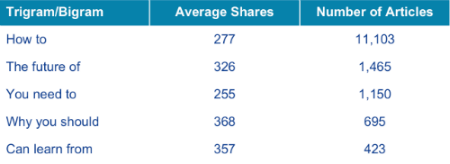
Most impactful headline words and topics
Rayson conducted the same exercise for single words or topics in headlines. His table below shows some of the best-performing words and their social reach.
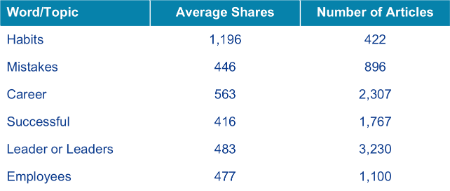
How can I write better headlines?
Rayson concludes from his analysis that LinkedIn’s top-performing content — in terms of shares — usually involves instruction on how to be successful in one way or another. This is probably no surprise, given the network’s career-oriented nature. But it can be useful to marketers who are looking to create and distribute content through this platform in the coming year.
Rayson’s takeaways offer some useful suggestions for framing LinkedIn content to improve reach and impact.
- Write about success: We all aspire to do better as professionals. LinkedIn is a place we come to find advice. The core topics that do well are personal success (tips, career advice, personal skills, leadership) and business success (team management, sales, including staying ahead on top of industry trends and case studies).
- Share advice and make it personal: Does your content provide practical advice to someone personally? It can range from boosting sales to managing a difficult employee or boss. Can you appeal to users on a very personal basis, e.g. you need to or you should.
- Focus on work: Will your insights make someone more successful at work? Can you distil this down into habits or tips or mistakes to avoid.
- Talk trends and the future: Can you provide insights into industry trends and help people gain a better perspective on the future?
- Stick with what works: If you find a format that works, do not be afraid to reuse it.
Related posts:

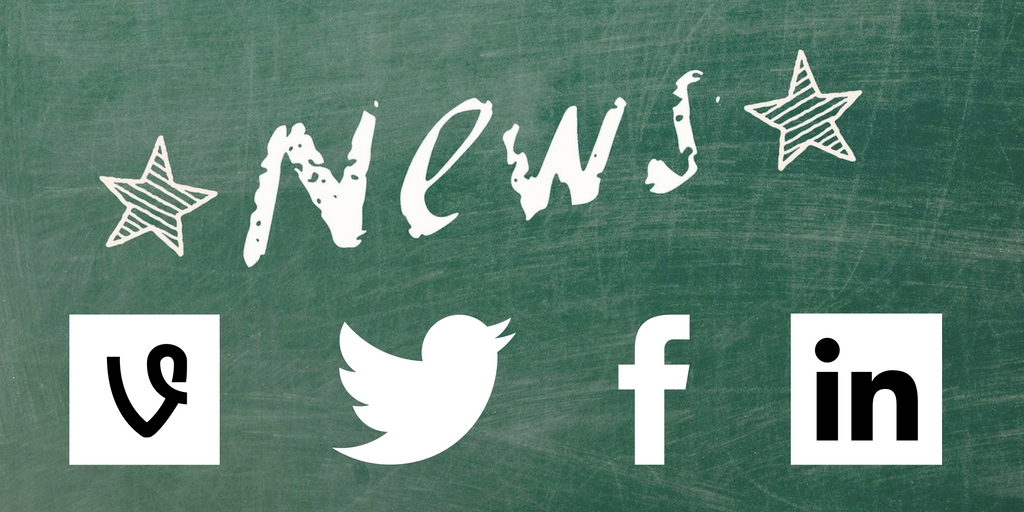
by Fronetics | Nov 2, 2016 | Blog, Marketing, Social Media, Supply Chain
Twitter will shut down its 6-second video platform; Facebook launches Recommendations feature; and more social media updates.
Twitter folds Vine
Twitter announced its plans to fold its video platform, Vine, in a Medium post on Thursday, October 27. The mobile app and website will not close immediately so that users can still access and download their Vines before they become unavailable.
The announcement follows news that Twitter would cut 9% of its workforce as it struggles to become profitable. Meanwhile, video platforms, like YouTube and Snapchat, and video capabilities on other social networks, like Instagram and Facebook, continue to soar in popularity. Read more
Facebook launches Recommendations feature and CTA buttons for local businesses
Facebook’s new Recommendations feature allows users to gather, map, and organize local business recommendations from their friends. You can pose a question, such as, “Where is the best place to buy paint?” and Facebook will auto-add extra information, like addresses and reviews, based on your friends’ responses.
Additionally, businesses can implement new call-to-action buttons to drive users to book an appointment, purchase tickets to an event, and more without ever leaving your business’ Facebook page. Read more
Facebook Live launches broadcasting tool for verified pages
Facebook Live’s new tool allows the administrators of verified pages schedule a live broadcast up to a week in advance, so that companies “can build anticipation and buzz” with their audiences. A page’s fans can wait in a virtual lobby as soon as three minutes prior to the launch of the broadcast.
As soon as a page schedules a broadcast, fans receive a notification in their newsfeeds and an option to schedule a reminder. Pages will receive a link to share or embed in websites, social media posts, and blogs. Read more
Simply Measured releases annual State of Social Marketing report
Social analytics company Simply Measured recently released its annual report regarding social media use by some of the biggest brands around the globe. The 2016 State of Social Marketing Report uncovered trends about a wide range of topics, but among the most interesting was the disconnect between how marketers are measuring social media success and what their leadership is asking for. Read more
More social media news and features to watch
Related posts:
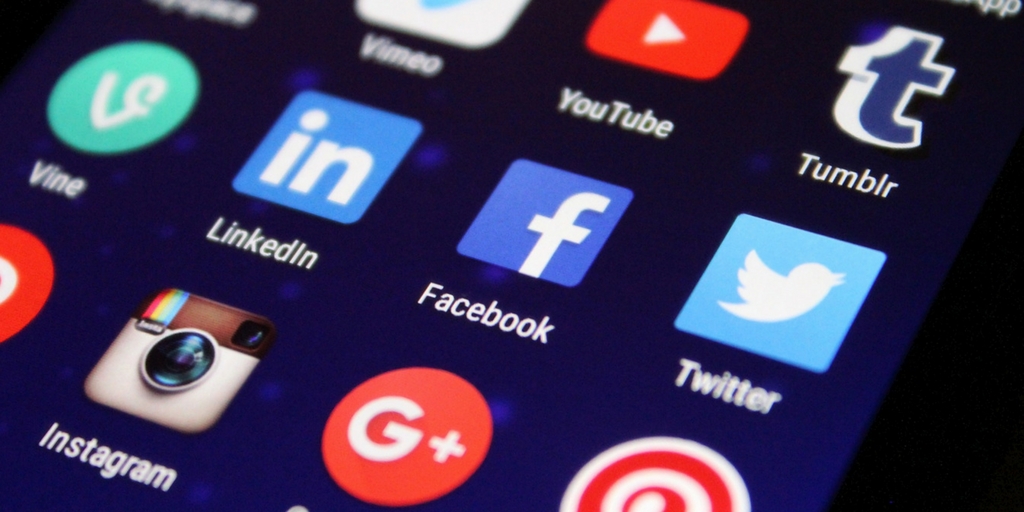
by Fronetics | Oct 4, 2016 | Blog, Content Marketing, Logistics, Marketing, Social Media, Supply Chain
This list of social media articles includes useful information for both people who rarely use social networking sites and for more advanced users.
We’ve been using this space to write about social media a lot lately. That’s partly because so many exciting new developments and enhancements keep popping up. It’s also because we can’t underscore enough how important it is for companies in the supply chain industry to participate in social media.
I thought it would be helpful to revisit some of our recent information, guides, and tips and tricks regarding social media use for B2B marketers. The following list encompasses both general, how-to-type instruction and more detailed advice for more advanced users.
I’ve segmented articles by platform and included a catch-all category at the bottom as well. Don’t see what you’re looking for? Shoot me an email to let me know what social media-related content you’d like to hear about on our blog.
LinkedIn
LinkedIn is the most popular social network for B2B companies. Here’s what you need to know to get started.
Learn about the free and paid methods LinkedIn offers to help you find and recruit new employees.
LinkedIn’s 433+ million member base presents an enormous opportunity for your company to earn new business. Start attracting those members to follow you.
Twitter
One of the top social media sites for B2B marketers, Twitter can help businesses spread brand awareness and communicate with customers.
You may find yourself frequently strapped for quality tweeting material. Here are some ideas to not only fill your feed but to keep your followers interested and engaged.
Leverage insights from Twitter’s analytics dashboard to improve audience engagement, reach, and content development.
We did an experiment to determine the ideal frequency for posting on Twitter. The resulting numbers were abysmal. But that means the experiment worked.
Add stickers to your photos on Twitter to join in on real-time conversations about trending topics and to grow your audience.
Twitter is changing its rules on the 140-character limit for your tweets. Learn what’s going to be different.
Facebook
Facebook Live offers businesses a new, creative platform for engaging customers. This article describes what marketers need to know about it and how to use it.
YouTube
YouTube is a useful engagement tool for B2B marketers who want to reach the social network’s more-than-3-billion users. Learn how to get started in this article.
Get started creating YouTube videos for your business with these easy-to-use tools and ideas for content.
Learn how to improve the reach of your YouTube videos with these strategies for distribution.
Reddit
Reddit is a gold mine for relevant, engaging content to share with your social media followers. Here’s how it works and how you can get started.
Other resources
Fronetics has developed this training specifically for business owners, marketers, and employees looking to learn more about social media and how they can contribute to their company’s success through these networks.
Fronetics has developed a comprehensive report exploring social media use in general and, specifically, within the logistics and supply chain industries.
Businesses are using social media as a strategic tool. This article explains the top three benefits companies in the logistics and supply chain industries can enjoy from participating on social platforms.
Your business should be on social media showing buyers that you know what they want and that your business can provide it.
A cross-departmental social media team can help your company get more out of social networking sites.
Participating in social media is not about earning followers; it’s about building relationships with your current and future customers.
If your social media strategy doesn’t align with your business objectives and target audience, your marketing budget is probably better spent elsewhere.

by Fronetics | Jun 21, 2016 | Blog, Content Marketing, Marketing, Social Media

Try these tips to attract potential customers to follow your business on LinkedIn.
This is part three of a three-part series on LinkedIn for B2B businesses. Check out part one, LinkedIn for B2B: Getting Started, and part two, How to Hire Talent through LinkedIn.
LinkedIn is a goldmine for organizations looking to build professional relationships and generate more quality leads. The 433+ million member base presents an enormous opportunity for your company to earn new business. But once you set up your company page, how can you start attracting those members to follow you? We’ve got 10 steps to get you started.
Keep in mind: Attracting followers can work like a domino effect — if you find the right people, that is. When you form an authentic LinkedIn relationship with someone, someone who is genuinely interested in your business and the content you distribute, that person is more likely to like, comment on, or share your updates. Then that person’s network will see that s/he engaged with your business. Not only does this provide exposure for your company, but also offers an endorsement of sorts. It encourages other people in your followers’ networks to follow you as well.
10 steps to attract LinkedIn followers
1) Entrust your colleagues.
Send around a company-wide email encouraging your employees to add your company to their LinkedIn profiles. When they do, your company name and logo show up on their profiles. Additionally, they automatically become followers of your company page and will receive your updates. If you can encourage them to like, share, and comment on your content, even better.
2) Tell your customers and partners.
Follow your customers and business partners on LinkedIn to prompt them to do the same for you. You can also let them know that you have a company page by including it in customer newsletters, your email signature, or other regular communications with them. Engage with their content on LinkedIn to stay top of mind and to get your business’ name in front of their followers as well.
3) Follow your competitors.
Get insight into what the competition is up to and how they are interacting with their followers. Make sure to like and comment on their content since their networks will see this activity (and, thus, your business’ name). You may even go further by following some of their customers and partners — you never know where a new business relationship might start!
4) Add a follow button to your website, social accounts, and content.
Don’t forget to add LinkedIn to your follow buttons on your website, blog, and other social media profiles. You can also add it to the share widgets on your content assets, like blog posts, emails, and landing pages. Doing so provides potential followers with an easy way to locate your company page or to share your content with their networks.
5) Write a blog post about it.
Announce the launch of your company page with a celebratory blog post. Enrich your post with keywords that resonate with your target audience, so potential customers searching the Internet might come across it and want to connect with you. Make sure to share the post through your other social media channels to encourage your followers there to find you on LinkedIn as well.
6) Join group discussions.
LinkedIn groups facilitate conversations about popular issues and hot topics in your industry. Though company pages cannot participate, individual employees partaking in the discussion represent their companies. (In fact, your company name is displayed under the employee’s name when they start a discussion.) Encourage your executives and other company leaders to find and join groups that relate to your business and to actively participate in dialogue. They can also share company updates or blog posts in these forums. Other group members will recognize their expertise and form a favorable opinion of the company — perhaps favorable enough to follow it.
7) Post regular content.
Keep yourself in your followers’ eyes by posting content at least several times a week. Keep in mind it doesn’t have to be all original content. In fact, it’s a smart idea to mix it up and share articles and posts by others that you find interesting. Users who come across your company page will recognize you as a source for frequent, relevant information, and will want to follow you to stay in the know.
8) Like, share, and comment on others’ content.
The more you interact with different members’ content, the more brand exposure you’ll get. Remember, the connections in members’ networks see details of your interaction in their newsfeeds. The more you interact with different people, the larger your reach.
9) Follow industry news and post on LinkedIn Pulse.
Keep up to date with the latest happenings and topics of conversation in your industry on LinkedIn Pulse. It’s a great way to gain inspiration for content. And posting to Pulse is an excellent way to attract followers. Millions of people browse and engage with Pulse conversations every day, so publishing can offer great exposure for your business.
10) Strategically utilize sponsored updates.
Your content can reach users outside of your company page’s followers and visitors through sponsored updates. The Campaign Manager tool will insert particular posts into a targeted audience’s LinkedIn newsfeeds. You just set your budget and choose cost-per-click or cost-per-1,000 impressions, and voilà! While few companies have the budgets for daily sponsored updates, these campaigns can be really effective at attracting followers when you have particularly compelling content to share.
Related posts:
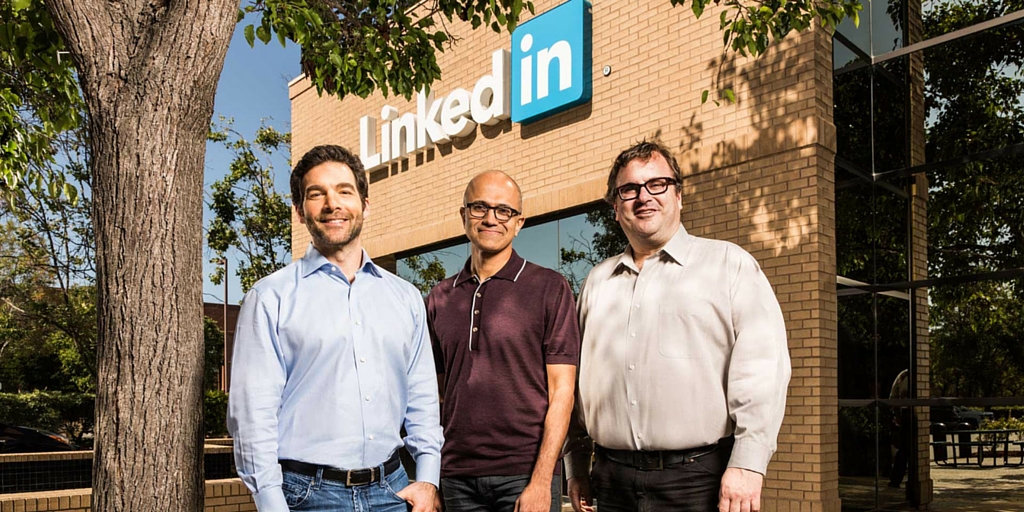
by Fronetics | Jun 20, 2016 | Blog, Current Events, Marketing, Social Media, Strategy

Source: Microsoft
The $26.2-billion acquisition could result in the customer-targeting solution(s) B2B marketers have been waiting for.
Microsoft announced on June 13 that it would purchase LinkedIn for $26.2 billion, a deal set to close by the end of 2016. Though LinkedIn will operate “as a fully independent entity within Microsoft,” the union will strengthen their shared mission to “connect the world’s professionals to make them more productive and successful.”
Both Sadya Nadella and Jeff Weiner’s letters to their employees beam with excitement over the possibilities for product synergies. “Think about it: How people find jobs, build skills, sell, market and get work done and ultimately find success requires a connected professional world,” writes Nadella. “It requires a vibrant network that brings together a professional’s information in LinkedIn’s public network with the information in Office 365 and Dynamics.”
Obvious opportunity lies in enhancing Microsoft’s existing solutions to improve user experience. For example, videos from Lynda.com, a website for training videos that LinkedIn bought in 2015, could be accessible throughout the Office suite, such as an Excel document.
But for B2B marketers, the most exciting possibilities involve “new opportunities … for monetization through individual and organization subscriptions and targeted advertising,” as Nadella puts it.
New opportunities for monetization
Jenny Sussin, a Gartner research director, proposes that LinkedIn’s value to Microsoft lies in its algorithms and user data. Successful integration into Microsoft’s existing products could be a game-changer for the B2B sphere, in terms of targeting customers.
First let’s consider the algorithms, two of which Sussin claims were the main attraction for Microsoft. “No. 1 was the algorithm that creates the connection graph, the social networking graph,” she says. “No. 2 was the algorithm that determines the information most valuable and most actionable to you.” Essentially, with this acquisition, Microsoft has the ability to map how professionals are connected and determine what content is most relevant to each individual user.
Secondly, LinkedIn has the most comprehensive, up-to-date personal data about its 433+ million global users of any professional network. And that data has not been available to other companies — LinkedIn even refused access to Google for ad sales — until now. The value of this information to any B2B organization is indisputable.
Now consider that there are 1.2 billion users of Office and 4.4 million users of Dynamics CRM. Microsoft can now combine the information it knows about those professionals with LinkedIn’s user data, map their relationships, and offer customized content within these products. Imagine being able to reach your target customer within the very tools s/he uses most every day.
And those are just two of Microsoft’s products. Skype, Yammer, MSN: there is no shortage of targeted advertising opportunities.
Taking on Google?
Perhaps the most exciting of these secondary properties for B2B marketers is Bing, Microsoft’s search engine. Bing Ads are attractive to marketers because of the low cost per conversion. The problem, of course, is volume, as Google dominates the market share.
But with LinkedIn’s data and algorithms, Bing could become “what search is sorely lacking today for B2B targeting,” says Marketing Mojo CEO Janet Driscoll Miller.
“Search marketing is great for determining intent — for understanding what a person wants,” Miller explains. “But social media platforms, like LinkedIn, tell us who the person is. Marrying the two pieces of data — who and what — brings us to the sweet spot of marketing and targeting an ideal audience. LinkedIn provides us with demographic targeting based on business and professional user information.”
Targeting could include factors like company size (e.g., spending capabilities), so marketers would not waste impression dollars advertising products that are far beyond the buyer’s price point. Fold in other LinkedIn solutions, like Lead Accelerator, to improve retargeting, and Bing Ads could really compete.
Google may have a leg up in terms of search volume, but without detailed data on users’ professional demographics, Bing could corner the market as the most effective B2B ad targeting platform.
Cause for caution
While the marriage of LinkedIn and Microsoft’s capabilities shows great promise, hold off on celebrating just yet.
Part of LinkedIn’s value to Microsoft derives from user-provided information. And part of Microsoft’s value to B2B marketers lies in its products’ ubiquity. But what if people stopped contributing their personal details to LinkedIn because of the way it was being used across the Microsoft suite? And what if businesses stopped using Microsoft products over privacy or data security concerns?
Here’s why those are both real concerns: Nadella suggests that your LinkedIn newsfeed could show relevant articles based on the projects you’re working on offline. Taking information from my desktop?! That’s problematic from both a personal and proprietary standpoint. Issues around invasion of privacy and the breech of secure business information could present major roadblocks to success.
How would you feel if a software product you researched yesterday appeared in your Outlook today? If, while preparing a PowerPoint for a client meeting, a pop-up suggested you contact a connection in your LinkedIn network who is an expert on the topic? With the deal projected to close before the end of the year, users reactions to these concerns over the next few months could be telling.
Related posts:








